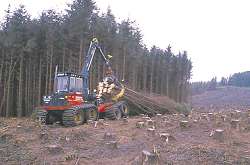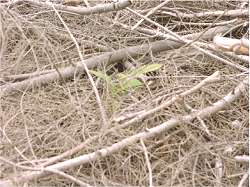Summary
Current research in this area aims to identify those soils where nutrient resources may be compromised if tree residues are not left on site as is the case for whole-tree harvesting (removal of most branches and needles from a harvesting site, in addition to the stem wood that is removed in conventional harvesting).
 Advances in harvesting technology mean that all branches and foliage can be removed from a site for ease of extraction or for use as an energy source. Branches and foliage have much higher concentrations of nutrients than stem wood. Brash removal, particularly from nutrient poor sites, represents a substantial source of nutrients while its removal may also lead to soil acidification. However, brash left on site can lead to eutrophication on sites where nitrogen saturation is a potential problem.
Advances in harvesting technology mean that all branches and foliage can be removed from a site for ease of extraction or for use as an energy source. Branches and foliage have much higher concentrations of nutrients than stem wood. Brash removal, particularly from nutrient poor sites, represents a substantial source of nutrients while its removal may also lead to soil acidification. However, brash left on site can lead to eutrophication on sites where nitrogen saturation is a potential problem.
A long-term experimental monitoring project is ongoing on three sites specifically selected to form a well defined gradient of soil nutrient regime (from very poor to the upper boundary of poor) according to the ecological site classification.
Research Objectives
 An ongoing experiment on brash management practices in Tugley Wood, Chiddingfold, West Sussex is investigating the most suitable management of brash for encouraging broadleaf regeneration following clearfelling of conifers on lowland sites. Specific research focus includes:
An ongoing experiment on brash management practices in Tugley Wood, Chiddingfold, West Sussex is investigating the most suitable management of brash for encouraging broadleaf regeneration following clearfelling of conifers on lowland sites. Specific research focus includes:
- The effects of brash management on soil quality and chemical status
- Natural seedling regeneration under different brash management treatments
- Changes in ground flora, particularly the development of ‘weed’ species
- The effects of brash management on the decay of conifer brash.
Findings and recommendations
This research shows:
- Significant decreases in second rotation growth associated with brash removal from a nutrient poor site
- Brash left on site has a positive effect on N, P, K availability and growth increment
- Brash retention alone appears unlikely to provide sufficient nutrition for optimum long-term tree growth on poorer sites.
